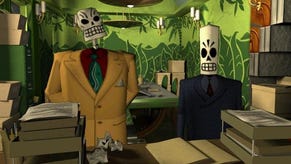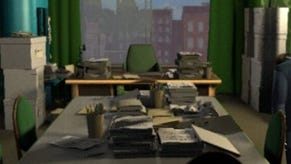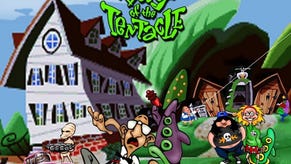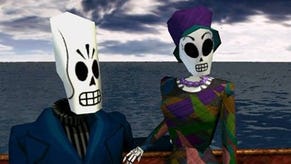Grim Fandango Remastered review
Bone idol.
There's a line in the new Grim Fandango Remastered's Director's Commentary that sums it up perfectly: "When you're making something, it should be something that only has been made by you, at the time you made it, in the place you made it." More than most games, never mind adventures, it's impossible to imagine any other team having made the original. It's a credit to every member of it that if this new Remastered edition doesn't seem to have changed all that much, it's because there really wasn't much in need of updating. Like the film noir classics it borrows from, it looked and sounded great at release, and still holds onto its style.
There's no arguing Grim Fandango's pedigree. It's one of the most beloved adventures of all time, and one of the few deemed worthy of sharing a VIP room with the likes of Monkey Island and Day of the Tentacle. For the most part, it deserves that. Main character Manny Calavera in particular is easily one of Lucasarts' finest creations; a grim reaper/travel agent for the dead on a four year journey through the underworld in search of the woman whose destiny he lost. His Art Deco world of Mexican papier-mâché dolls is a work of creative genius, from the Brazil style technology of opening city El Marro to the moonlit waters of Rubacava. Every scene is lovingly rendered, every piece of music so good that it's impossible to imagine anything else going in its place, every conversation sparkles with wit and warmth. Some details of the plot are best not thought over too carefully, especially the nature of Manny's job and trying to do Glengarry Glen Ross in a world where the best clients are given freebies for their good lives, but hey. The heart and style of it easily papers over those pesky cracks.
Grim Fandango Remastered wisely doesn't mess with any of this, avoiding any heavy-handed modernisation like the updates that made the original Secret of Monkey Island Special Edition such a pile (the sequel was better). Instead, it increases the texture quality so that characters are as sharp as they should be, adds a few lighting effects that aren't particularly dramatic but don't hurt, and introduce a point-and-click interface to go along with the original's tank controls (plus a certain pointed achievement if you play through it the old fashioned away). This annoyingly can't distinguish between 'use this' and 'use item on this' though, so you still have keep putting things away to interact with them, and go to a separate screen to check and select inventory items. One puzzle, involving pulling levers, had me at the keyboard before a solution would work. Those are are very minor irritations though.
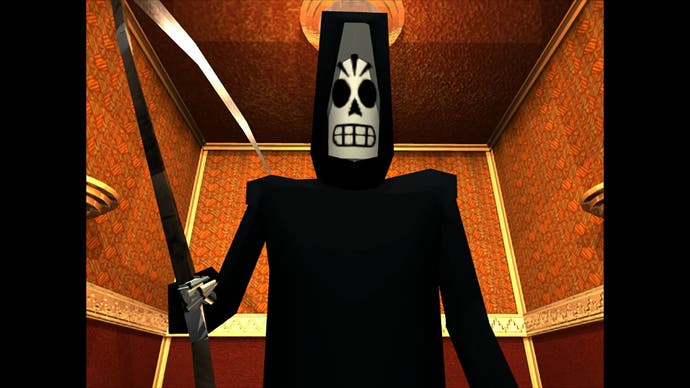
Backgrounds have been upscaled, but otherwise left alone. The result is that they look a little soft, especially against the now crisp 3D models, but the amount of detail and artistry in them means that this quickly fades out of relevance. By default, Remastered runs in 4:3 with decorative borders to fill the space, but it's possible to get rid of those, or play it in widescreen if you really must - though that's a simple stretch-out job and as such looks very ugly. In a perfect world, they'd have been redone. Realistically, that was never, ever going to happen.
In short, while this isn't the most comprehensive remaster ever made, it's a smart and considered one that focuses on bringing you the Grim Fandango you remember in your head rather than necessarily the one you played, with the differences revealed by switching off the new graphical features from the main menu (which you can do at any time). Remastered's only major real dropped ball is, strangely and rather boringly, save games. You only get eight slots, and there's no auto-save. That's an bizarre omission, and an unfortunate one. I had a few crashes while playing, particularly at the end of cut-scenes, and usually right in the middle of thinking "Oh, yeah, it's been quite a while since I sav- yaaaaaaaargh!"
Finally, there are some bonus features - a concept art gallery, and that commentary mode with everyone from creator Tim Schafer to the QA tester chipping in with their memories and pointers. Just about every screen has at least one comment on it, and the background stories are worth listening to. That said, it would have been good if the button to play the node said what it was going to be about, especially with multiple nodes tucked away on some screens.
There's nothing major to quibble with about the remastered edition then, especially since it's not as though the game has been officially available for years (which also helps compensate for the fact that PC owners have had access to a few of the improvements for a while via the ResidualVM project and an 'acquired' copy). Onto the game itself, where we really have to start with the fact that while Grim Fandango is excellent, not all of it has aged as well as its writing and atmosphere. When it's good, make no mistake, it's very, very, very good. Its fame is warranted. The first year, El Marrow, is a clever idea around every corner, and the second, Rubacava, a love letter to noir in ways that games like LA Noire can only dream of being. Grim Fandango is a game of wonderful moments and characters, lines and bits of scenery, and it's been so long since it came out that you're guaranteed to smile at some of it like it's the first time through. I'd completely forgotten the scenes between Manny and Carla for instance, the security guard who longs to jump his bones, and her irritation that he only wants her for one thing - her metal detector. It's a great cast and a great script, with part of the charm of Rubacava being the sense of untold history between the various players.
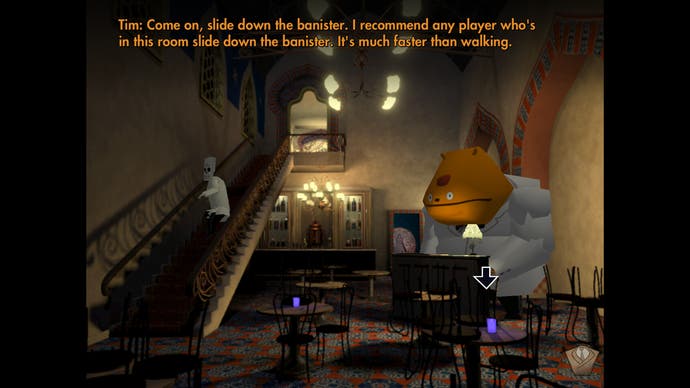
When it comes to puzzles though, things get messy. It's not that they're hard, but that they often feel like they're trying too hard. There's a line between 'fiendish' and 'annoying', and between 'hard' and 'opaque'. Many of Grim's puzzles were pushing their luck in the 90s when this kind of design was considered all part of the fun. Now though, thinking back on both Schafer's other games (Full Throttle springs to mind, where puzzles played second-fiddle to everything else) and the adventures that followed, many of them may as well come with a Post-It note linking to a decent walkthrough. The Petrified Forest section that ends the first act was especially garbage when Grim Fandango originally came out. It's only the worse for both another 15 years and comments by the production manager about her efforts to cut it out of the game with a machete. Lleslle, you were right! Get through that to Rubacava (far and away the best part of the game) and not only are the puzzles still often borderline opaque, the sheer size of the town means burning at least three shoes worth of leather just getting around. A teleporter map would have been a great Remastered addition. Honestly, even a basic map wouldn't have hurt.
It's a rare classic that doesn't have something that could have been improved in retrospect though. Grim Fandango's duff puzzles - and we're not talking all of them by any means - are easily batted away with a quick trip to Google, and it's not long before you're back to the things that make it great. The dialogue, Glottis, the atmosphere, the little incidental animations, Glottis, the voices, the music. And Glottis.
Definitely be careful of rose-tinted memories. The puzzles and its relatively early peak can't and shouldn't be ignored. Nor though can everything that it does right, from its sheer heart and creative polish, to the genius of its ideas and characters. Even when it stumbles, it stands as a fine reminder of why LucasArts at its prime was seen as the industry at its best, and few other adventures have deservedly gathered so much affection. It was an instant classic back in 1998. It's still very much a journey worth taking today, albeit ideally with a walkthrough.
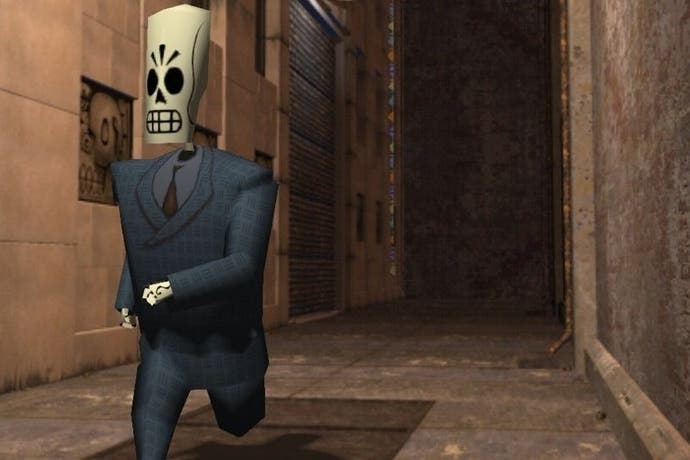

.jpg?width=291&height=164&fit=crop&quality=80&format=jpg&auto=webp)



